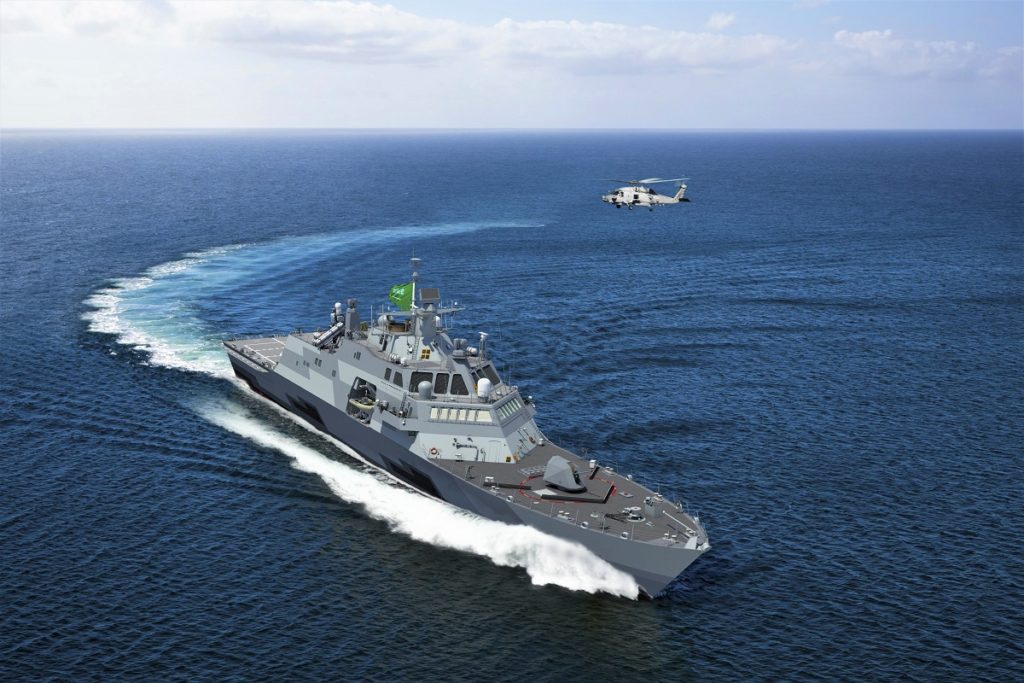Zarvan
ELITE MEMBER

- Joined
- Apr 28, 2011
- Messages
- 54,470
- Reaction score
- 87
- Country
- Location
According to information published on www.ekathimerini.com website on November 6, 2020, the Hellenic (Greek) Navy would like to purchase four American Multi-Mission Surface Combatant (MMSC) frigates. The MMSC is a tailored littoral combat ship variant being built by American Company Lockheed Martin for the Kingdom of Saudi Arabia through the U.S. Navy’s Foreign Military Sales (FMS) program.
Follow Navy Recognition on Google News at this link

Scale model of the Royal Saudi Navy MMSC on Lockheed Martin booth at SNA 2018. (Picture source Navy Recognition)
Citing the www.ekathimerini.com website, following an intergovernmental agreement, Greece could purchase four MMSC frigates, the upgrade of four MEKO-type frigates, intermediate solution ships, and the participation of Greek shipyards in the development of the new American FFG(X) type frigate.
The Multi-Mission Surface Combatant (MMSC) is a lethal and highly maneuverable multi-mission surface combatant capable of littoral and open-ocean operation. It was designed from the keel up to confront modern maritime and economic security threats.
The MMSC takes the proven capabilities of the U.S. Littoral Combat Ship and the inherent flexibility of the Freedom-variant hull to meet the unique maritime requirements of international navies. The Multi-Mission Surface Combatant has a range of 5,000 nautical miles and can reach speeds in excess of 30 knots. It will be based on the Freedom-variant Littoral Combat Ship’s 118-meter hull and it will utilize the same combined diesel and gas propulsion system.
With proven combat management system lineage, Lockheed Martin’s MMSC has the interoperability necessary for today’s joint and allied naval force maneuvers. Paired with the world’s most advanced maritime helicopter, the MH-60R SEAHAWK®, the MMSC will have a robust anti-submarine mission capability that is fully interoperable with the U.S. Navy and its coalition partners.
The MMSC utilizes the COMBATSS-21 Combat Management System, built from the Aegis Combat System Software library. The MMSC integrated combat system solution leverages the domestic LCS integration of the 57mm Mk110 deck gun and SeaRAM, and expands multi-mission capability through integration of Over-The-Horizon surface-to-surface missiles, port and starboard 20 mm remote guns, a new fire control radar and a forward centerline 8 cell MK 41 Vertical Launch System equipped with RIM-162 Evolved Sea Sparrow Missiles. The MMSC is also equipped with the AN/SLQ-25 Torpedo Defense system.
The FFG(X) type frigate now named Constellation-class is a multi-mission guided-missile frigates under development for the United States Navy as a follow-on to the modular littoral combat ship. he FFG(X) was announced in a United States Department of Defense Request For Information (RFI) on 10 July 2017. On 30 April 2020, it was announced that Fincantieri Marinette Marine had won the contract to build the new type of frigate.

 www.navyrecognition.com
www.navyrecognition.com
Follow Navy Recognition on Google News at this link

Scale model of the Royal Saudi Navy MMSC on Lockheed Martin booth at SNA 2018. (Picture source Navy Recognition)
Citing the www.ekathimerini.com website, following an intergovernmental agreement, Greece could purchase four MMSC frigates, the upgrade of four MEKO-type frigates, intermediate solution ships, and the participation of Greek shipyards in the development of the new American FFG(X) type frigate.
The Multi-Mission Surface Combatant (MMSC) is a lethal and highly maneuverable multi-mission surface combatant capable of littoral and open-ocean operation. It was designed from the keel up to confront modern maritime and economic security threats.
The MMSC takes the proven capabilities of the U.S. Littoral Combat Ship and the inherent flexibility of the Freedom-variant hull to meet the unique maritime requirements of international navies. The Multi-Mission Surface Combatant has a range of 5,000 nautical miles and can reach speeds in excess of 30 knots. It will be based on the Freedom-variant Littoral Combat Ship’s 118-meter hull and it will utilize the same combined diesel and gas propulsion system.
With proven combat management system lineage, Lockheed Martin’s MMSC has the interoperability necessary for today’s joint and allied naval force maneuvers. Paired with the world’s most advanced maritime helicopter, the MH-60R SEAHAWK®, the MMSC will have a robust anti-submarine mission capability that is fully interoperable with the U.S. Navy and its coalition partners.
The MMSC utilizes the COMBATSS-21 Combat Management System, built from the Aegis Combat System Software library. The MMSC integrated combat system solution leverages the domestic LCS integration of the 57mm Mk110 deck gun and SeaRAM, and expands multi-mission capability through integration of Over-The-Horizon surface-to-surface missiles, port and starboard 20 mm remote guns, a new fire control radar and a forward centerline 8 cell MK 41 Vertical Launch System equipped with RIM-162 Evolved Sea Sparrow Missiles. The MMSC is also equipped with the AN/SLQ-25 Torpedo Defense system.
The FFG(X) type frigate now named Constellation-class is a multi-mission guided-missile frigates under development for the United States Navy as a follow-on to the modular littoral combat ship. he FFG(X) was announced in a United States Department of Defense Request For Information (RFI) on 10 July 2017. On 30 April 2020, it was announced that Fincantieri Marinette Marine had won the contract to build the new type of frigate.

Hellenic Navy plans to purchase four American-made Multi-Mission Surfa
google_ad_client = "ca-pub-4068738923530102"; /* Navy Recognition 468x15 link */ google_ad_slot = "6873402760"; google_ad_width = 468; google_a







